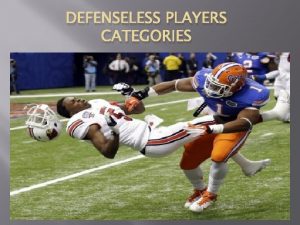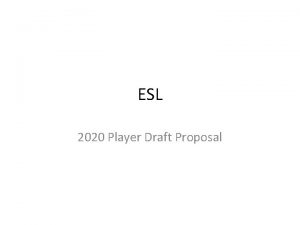CHAPTER 13 GUIDING THE PLAYER 1 Topics Guiding




























- Slides: 28

CHAPTER 13 GUIDING THE PLAYER 1

Topics Guiding the Player Direct Guidance – Overt instruction Indirect Guidance – Covert instruction Teaching New Skills and Concepts 2

Guiding the Player The more you work on a game, the more you internalize its systems and levels However, a new player won't have any of that knowledge You must ensure that players who have never seen your game before intuitively understand it This requires careful, sometimes invisible guidance Two types of guidance – Direct Guidance - The player knows that she is being guided – Indirect Guidance - The player is guided without realizing it 3

Methods of Direct Guidance Instructions – The game explicitly tells the player what to do – These can take the form of • Text • Dialogue with an authoritative non-player character (NPC) • Visual diagrams – Often incorporate combinations of the three – One of the clearest forms of direct guidance – Drawbacks • May overwhelm the player with too much information • May annoy the player by pedantically presenting information she already knows 4

Methods of Direct Guidance Call to Action – The game explicitly gives the player an action to perform and a reason to do so – Often takes the form of missions given by NPCs – Common strategy • Present the player with a clear long-term goal • Then give her progressively smaller medium- and short-term goals that must be accomplished on the way to the long-term goal – Example: The Legend of Zelda: Ocarina of Time • Long-Term Goal: Navi tells Link that he has been summoned by the Great Deku Tree. Link is told by another NPC this is a great honor. • Smaller Goals: Link's path to the Great Deku Tree is blocked by Mido, who tells him that he will need a sword and shield before venturing into the forest • The short-term goals are directly tied to the long-term goal of reaching the Great Deku Tree 5

Methods of Direct Guidance Map or Guidance System – Many games include a map or GPS-style guidance system – Directs the player toward her goals or toward the next step in her mission – Example: Grand Theft Auto V • Radar/mini-map in the corner of the screen with a highlighted route for the player to follow to the next objective • In the vast world of GTA V, the player relies very heavily on the GPS – Drawbacks • Can lead to players spending most of their time just following the directions of the virtual GPS • Players don't thinking about a destination and choose their own path • Takes longer for the player to learn the layout of the game world 6

Methods of Direct Guidance Pop-Ups – Contextual controls that change based on the objects near the player – Example: Assassin's Creed IV: Black Flag • The same button controls such diverse actions as – Opening doors – Lighting barrels of gunpowder on fire – Taking control of mounted weapons • Pop-ups with the icon for the controller button and a very short description of the action appear when a contextual action is possible 7

Judging the Quality of Direct Guidance The various methods of Direct Guidance can all be judged by the same four criteria – – Immediacy Scarcity Brevity Clarity 8

Judging the Quality of Direct Guidance Immediacy – The message must be given to the player when it is immediately relevant • Don't try to tell the player all the possible controls for the game at the very beginning unless they are very simple – Direct information about controls should be provided immediately the first time that the player needs it – Example: Kya: Dark Lineage • A tree falls into the path of the player character, and she must jump over it to continue • As it is falling, the game shows the player the message "Press X to jump" at exactly the time she needs to know that information 9

Judging the Quality of Direct Guidance Scarcity – Many modern games have lots of controls and lots of simultaneous goals – The player must not be flooded with too much information all at one time – Making direct controls more scarce makes them more valuable to the player and more likely to be heeded – This is also the case with missions • A player can only really concentrate on a single mission at once • If a game gives the player too many simultaneous missions, many will eventually be ignored • Example: Skyrim – The author currently has >200 unfinished missions in Skyrim – Average amount of time spent playing Skyrim is 90 hours person! – Though released in 2011, as of July, 2014, over 60, 000 people on Steam still play Skyrim daily (#6 most popular game!) – But only 30. 7% of owners on Steam have ever finished the main quest 10

Judging the Quality of Direct Guidance Brevity – Never use more words than are necessary – Don't give the player too much information at one time – Example: Valkyria Chronicles • A tactical combat game by Sega • "When near sandbags, press O to take cover and reduce damage from enemy attacks. " Clarity – Be very clear about what you're trying to convey – Example: Valkyria Chronicles • Why not just "When standing near sandbags, press O to take cover" • In Valkyria Chronicles, cover not only shields you but also drastically reduces the amount of damage you take from bullets that do hit • For the player to understand everything she needs to know about cover, she must also be told about the damage reduction. 11

Indirect Guidance Much more subtle than Direct Guidance Even as a designer you may not have noticed it Seven methods of Indirect Control — An expansion of Jesse Schell's six methods from The Art of Game Design – Constraints – Goals – Physical Interface – Visual Design – Audio Design – Player Avatar – Non-Player Characters 12

Seven Methods of Indirect Guidance Constraints – If you give the player limited choices, she will choose one • If given a choice of Red or Green, the player won't try to pick Blue – Without constraint, players run the risk of choice paralysis • A person is presented with so many choices that she can't weigh them all against each other and instead just doesn't make a choice • This is why a restaurant menu might have 100 different items but only feature images of 20 Goals – Goals can also be used to guide the player indirectly – If the player has a goal to collect bananas the player to head toward the door with bananas – Materials, abilities, and circumstances can also influence the autotelic goals that players set for themselves • Example: Minecraft – Players in danger are given the ability to craft 13

Seven Methods of Indirect Guidance Physical Interface – The shape of a physical interface can be Indirect Guidance – If you give the player a guitar-shaped controller, she will generally expect to use it to play music – Giving a Guitar Hero player a regular game controller might lead her to think that she could control her character's movement around the stage – The rumble feature on controllers can also provide guidance • Example: Rumble strips in racing games 14

Seven Methods of Indirect Guidance Visual Design — The broadest category of Indirect Guidance – Light • Humans are naturally drawn to light • If you place a player in a dark room with a pool of light at one end, she will often move toward that light before exploring anything else – Similarity • Once a player has seen that something in the world is good in some way (helpful, healing, valuable, etc. ), she will seek out similar things – Trails • Similarity can lead to a breadcrumb-trail-like effect • The player picks up a certain item and then follows a trail of similar items to a location that the designer wishes her to explore 15

Seven Methods of Indirect Guidance Visual Design – Landmarks • Large interesting objects can be used as landmarks • Example: Journey by thatgamecompany – The player starts in the middle of a desert next to a sand dune – Everything around her is the same color except for a dark stone marker at the top of the tallest nearby dune – The player is driven to move up the dune toward it – Once she reaches the top, the camera rises above her, revealing a towering mountain with light bursting from the top – The camera move causes the mountain to emerge from directly behind the stone marker, showing the player that the mountain is her new goal 16

Seven Methods of Indirect Guidance Visual Design – Arrows • Subtle arrows can be used to guide the player • Example: Uncharted 3 17

Seven Methods of Indirect Guidance Visual Design – Camera • Commonly used in traversal puzzles (looks in direction of next move) • Example: Uncharted 3 18

Seven Methods of Indirect Guidance Visual Design – Contrast • Used to draw attention to certain objects • Directionality – Image A: Horizontal rungs contrast with vertical elements in scene • Brightness – Image B: Edges are marked with bright/dark borders • Texture – Image C: Smooth cloth texture provides texture contrast with rough rock and wood • Color – Image D: Blue cloth and yellow pipes contrast with beige environment 19

Seven Methods of Indirect Guidance Audio Design – Music can influence a player's mood • Slow, quiet music can lead the player to be more stealthy • Raucous, boisterous music can make the player more bold – Sound effects can draw attention to possible player actions or hidden objects • Example: Assassin's Creed 4 & Tomb Raider (2013) – Special sounds are used to alert the player when a treasure chest (AC) or hidden tomb (TR) is nearby Player Avatar – A player's character model can have a strong guiding effect – If the player character looks like a rock star with a guitar… • The player will expect for her character to be able to play music – If the player character has a sword… • The player will expect to be able to hit things and run into combat 20

Seven Methods of Indirect Guidance Non-Player Characters – Modeling Behavior • The NPC shows the player good or bad behavior and the consequences – Example: Kya: Dark Lineage – Negative behavior • NPC shows what NOT to do • Image A: Red circle shows a Nativ who stepped in a trap and was caught – Positive behavior • NPC shows proper bahavior • Image A: Green circle shows Nativ jumping to avoid trap • Image B: Green circle shows Native stopping to wait for wind trap 21

Seven Methods of Indirect Guidance Non-Player Characters – Safety • Image C & D: Green circle shows Nativ taking potentially-dangerous action • Because the Nativ shows confidence doing so, the player doesn't fear 22

Seven Methods of Indirect Guidance Non-Player Characters – Emotional Connections • Players can be influenced by their emotional connections to NPCs – Example: Journey • Image A: The player encounters the first other creature she has seen in the game • Image B: When the creature flies off, the player follows it (presumably to avoid loneliness) – Players also chase NPCs out of anger (Assassin's Creed 4) 23

Teaching New Skills and Concepts When games were simpler, this wasn't an issue – Super Mario Bros. had on the NES controller had • 1 D-Pad - Direction • A - Jump • B - Run or Toss Fireball • Start & Select Buttons – With today's games, it's much more complex • 1 D-Pad • 2 Analog Sticks • A, B, X, Y, LB, RB, L-Stick, R-Stick, Start, & Back Buttons • Left and Right Analog Triggers – Even then, many buttons on the controller are used for multiple actions With so many controls, training of the player must be sequenced properly 24

Teaching New Skills and Concepts Sequencing — The art of gently presenting new information – Isolated Introduction • The player is introduced to the new mechanic such that she must use it to continue • No time pressure or danger of injury – Expansion • Expands use of the new mechanic • Still not penalty for failing to do so correctly – Adding Danger • Some danger (penalty for failure) is added • Success is still relatively easy – Increased Difficulty • Player must now demonstrate mastery over the new mechanic – Integration • Once the player understands the mechanic, she is required to integrate it with other mechanics in the game 25

Teaching New Skills and Concepts Example: – Kya: Dark Lineage (PS 2) – Isolated Introduction: A • Player must press X to drop below the wall – Expansion: B • Player must pump X to hover – Adding Danger: C & D • Dangerous areas are red • Can pass C without pressing X • Can just hold X to pass D – Increased Difficulty: E & F • Player must pump X to pass without damage 26

Judging the Quality of Indirect Guidance Ask the following questions to judge your indirect guidance: – What percentage of players acted in the way that you intended? – How aware were the players that their actions were being influenced? – How important is it to you that the guidance is covert? – In other words, how important is it to you that the player feels like she made the decision on her own? 27

Chapter 13 – Summary Both direct and indirect guidance are very important to today's complex games Various methods exist for each Sequencing is an excellent way to teach new skills Next Chapter: The Digital Game Industry – Information about the game industry – Should you go to school for game design? – How to meet people in the game industry 28
 Guiding storytelling experiences
Guiding storytelling experiences Hát kết hợp bộ gõ cơ thể
Hát kết hợp bộ gõ cơ thể Frameset trong html5
Frameset trong html5 Bổ thể
Bổ thể Tỉ lệ cơ thể trẻ em
Tỉ lệ cơ thể trẻ em Gấu đi như thế nào
Gấu đi như thế nào Thang điểm glasgow
Thang điểm glasgow Hát lên người ơi
Hát lên người ơi Kể tên các môn thể thao
Kể tên các môn thể thao Thế nào là hệ số cao nhất
Thế nào là hệ số cao nhất Các châu lục và đại dương trên thế giới
Các châu lục và đại dương trên thế giới Công thức tiính động năng
Công thức tiính động năng Trời xanh đây là của chúng ta thể thơ
Trời xanh đây là của chúng ta thể thơ Mật thư anh em như thể tay chân
Mật thư anh em như thể tay chân 101012 bằng
101012 bằng độ dài liên kết
độ dài liên kết Các châu lục và đại dương trên thế giới
Các châu lục và đại dương trên thế giới Thể thơ truyền thống
Thể thơ truyền thống Quá trình desamine hóa có thể tạo ra
Quá trình desamine hóa có thể tạo ra Một số thể thơ truyền thống
Một số thể thơ truyền thống Cái miệng xinh xinh thế chỉ nói điều hay thôi
Cái miệng xinh xinh thế chỉ nói điều hay thôi Vẽ hình chiếu vuông góc của vật thể sau
Vẽ hình chiếu vuông góc của vật thể sau Biện pháp chống mỏi cơ
Biện pháp chống mỏi cơ đặc điểm cơ thể của người tối cổ
đặc điểm cơ thể của người tối cổ Thứ tự các dấu thăng giáng ở hóa biểu
Thứ tự các dấu thăng giáng ở hóa biểu Vẽ hình chiếu đứng bằng cạnh của vật thể
Vẽ hình chiếu đứng bằng cạnh của vật thể Fecboak
Fecboak Thẻ vin
Thẻ vin đại từ thay thế
đại từ thay thế




















































